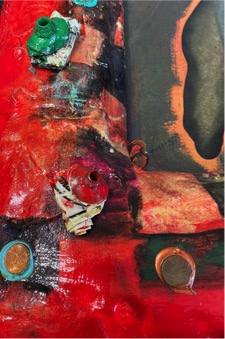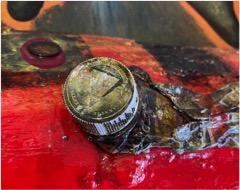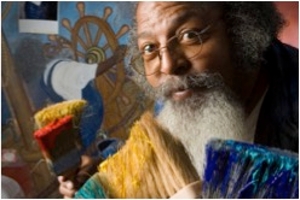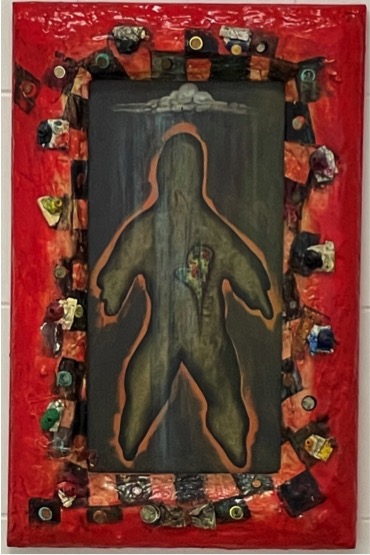Public Art on Campus - Burt Long, Jr.
ART ON CAMPUS
Title: Important, Not Important
Year: 1987
Medium: Acrylic on canvas with Hydrostone Frame and Mixed Collage
Location: Education Building South Stairwell
Gift of Rob Clark and Jerry Thacker
The frame of “Important, Not Important” is the star of this classic representation of Bert Long’s art. The underlying wood is covered with Hydrostone, a type of plaster used by artists to build up surfaces. As though applying layers to a dense cake, Long molded the Hydrostone to a depth of almost four inches. The brightly painted red surface is embellished with used paint tubes and various coins – quarters, nickels, dimes, pennies. Though coins no longer have the value they once did, when Bert was a child, and well into the 60s, the coins glued to this frame could have easily fed two people for a day.
Nestled within the frame is a painting of a shadowy figure with no defining identification as male or female. Hands and feet appear as amorphous forms. In the area of the face, a pale reddish shape is visible – perhaps a round mouth spewing liquid. On the chest is a colorful form, somewhat heart-shaped with a long stem pointing downward. Above the figure is a cloud formation. Visible brushstrokes flow downward through both the figure and background as though rain is pouring from the cloud. The figure is rendered in the same greenish gray tones as the background, defined only by the orange silhouette surrounding it.
There are no documents indicating Long’s meaning with this piece, but most of his art was created with purpose. Perhaps this is a self-portrait of Long working through some pain, a theme he frequently tackled. Of his infamous painting “Riding the Tiger” from 2000, he wrote:
Every day we wake up, and we get on this tiger. It’s on fire. There is no ground below it. The ocean is above it… The tiger has ferocious claws and a mouth full of teeth that will hurt you. Life is not easy. Life will chew you up, claw you up, set you on fire, toss you off a ravine, and pound your ass. And what you have to do every day is wake up and say, 'Okay, I’m ready to get on that tiger!'
Long was a large man with an even larger personality. He frequently dressed in overalls, his long beard flowing onto his chest. He always wore an elaborate handmade pendent around his neck, typically one adorned with an eyeball, his signature trademark. Bert Long lived life to the fullest - a cheerful, happy and engaging figure who expressed his trials and tribulations though his artwork rather than his personality.






